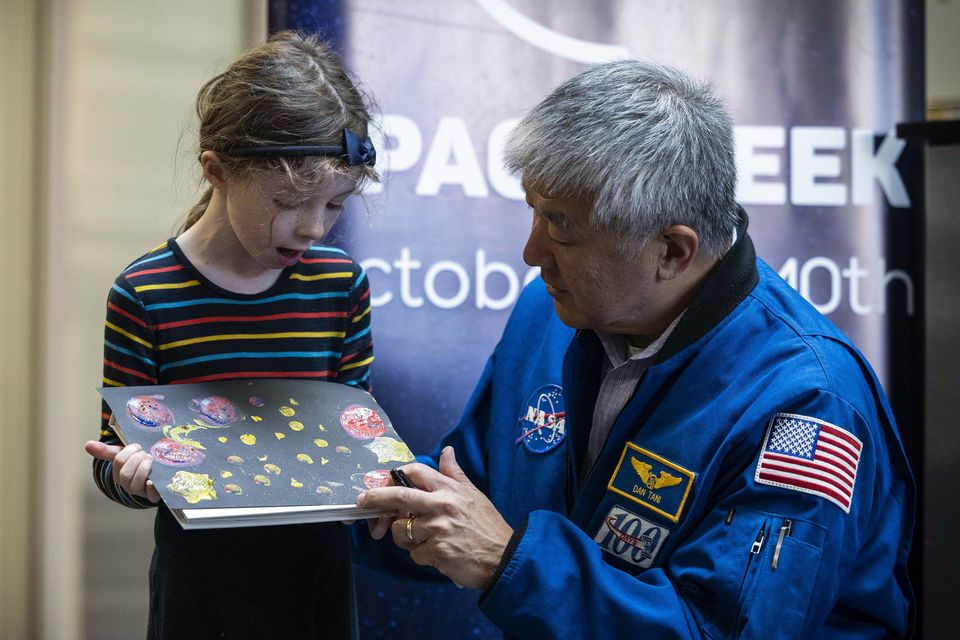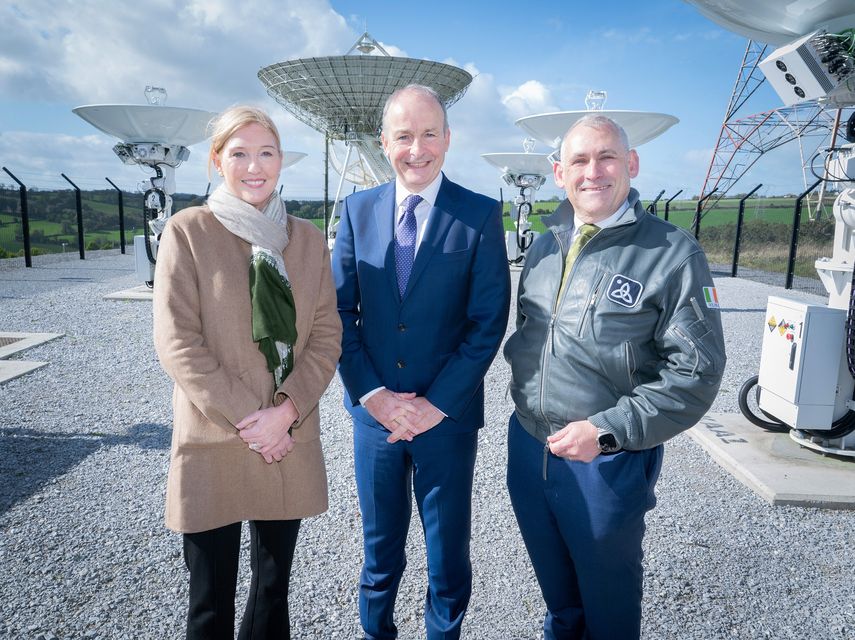MTU’s Dr Niall Smith has been joined by American engineer Dan Tani for Irish Space Week, showing children and young people that space travel and research needs much more than science
Coordinated by MTU Blackrock Castle Observatory, the nationwide programme invites students, families, artists, engineers and communities to explore how life on Earth can inform life beyond it, with the theme “Living in Space”.
Head of Research at MTU Cork Campus at the Cork Institute of Technology, Dr Niall Smith told the Irish Independent: “Irish people really connect into space, we see a lot of connections from schools and young people which is fantastic and we do the coordination from Blackrock Castle Observatory and actually what we celebrate is all of the individual events happening up and down the country.”
Over 450 events have been organised for this year’s Irish Space Week and last year’s 466 events saw 97,000 participants in the programme.
One of the topics at this year’s Space Week is how space can be utilised for predicting weather events on Earth such as flooding through satellite which Dr Smith explained can provide early warning data to prevent that from happening going forward.
Dr Smith also revealed that people will be sent to the moon once again by 2030 as well as possibly Mars for further research. “When people are in those extreme environments, what are the psychological conditions under which they exist? Therefore we need psychologists and social scientists to understand that, understand how we behave in long durations where there is no prospect of an early return to your family or even to your home planet.
“There’s so many things but we want people to think about them as opportunities and that they feel they can be part of taking advantage of those opportunities and not just watching from a distance as interested or less interested spectators.”
American engineer and retired NASA astronaut Dan Tani is also participating in this year’s Space Week. “It’s an opportunity once a year for people to think about space and recognise that it’s part of our life, for some people, to ignite an interest in the thing that we think of as space but what I am really looking forward to is meeting children.
“Kids that, maybe they’re excited about space already but maybe they don’t know as much about it to get excited and to tell the story of what it’s like to live in space, to travel into space. I’m hoping to ignite some imagination and some thought like ‘wow I’ve never thought about that, that’s really cool’.”
Mr Tani said he hoped to encourage children who may not be interested in science or engineering to see space as something they can still be a part of through other skillsets such as languages, law, art, writing and business.
He said: “Maybe your thing isn’t engineering, maybe it’s languages, well we’re going to have to really figure out language, how we deal with different people with different languages because when we go to the moon or certainly to Mars, we’re going to need people from all over the world and so we need to figure out what kind of language will we use for these really long trips.
“We’re going to need artists to convey maybe a unique experience or certainly even figuring out how to do the drawings that the procedures need, I guarantee you that for kids, if they grow up and see themselves in a particular field, whatever that field may be I’ll bet that we can use it in the space programme so that’s the seed I want to plant.”

Pictured:Former NASA astronaut Dan Tani delighting in Fiadh Newman of Inishshannon’s Space art work and knowlege of the Cosmos pictured at the first public event of Space Week Ireland 2025 which took place at the Cork School of Music
Both Dr Smith and Mr Tani emphasised that overall, the space industry is big and continuing to grow and so the skillsets needed are increasing rapidly.
Mr Tani said: “What I have found with, especially children, is when you say okay we’re going to talk about space and who here thinks space is really cool and everybody raises their hand and I go, okay, who here likes STEM and a third or half of the kids raise their hand, the other half kind of go oh well space is not for me and that’s really disappointing.
“I think I’d rather have everybody excited about the story and everybody excited about the imagination because these kids are going to be really accomplished and smart in something.”
Since the commencement of Space Week, the National Space Centre Ltd (NSC) joined Amazon’s Project Kuiper and Taoiseach Micheál Martin to mark the regulatory approval of a satellite earth station that will allow Project Kuiper to operate a gateway at NSC’s Elfordstown facility in Midleton, Cork.
The Commission for Communications Regulation (ComReg) has granted permission for operations within the 18 GHz and 28 GHz frequency bands, enabling the delivery of Project Kuiper’s satellite broadband services to Ireland.
Taoiseach Micheál Martin joined representatives from the NSC and Amazon at the Elfordstown facility for a ribbon-cutting ceremony to mark the occasion, he said:. “This approval aligns perfectly with our National Digital Strategy to ensure Ireland remains a leader in technology, with high-speed connectivity in every corner of our country by 2028.
“We welcome this partnership between the National Space Centre and Project Kuiper and look forward to the positive impact this will have.”
NSC’s 10-acre campus at Elfordstown has been providing commercial satellite services since 2010, serving as a vital hub for Ireland’s growing space industry. The addition of Project Kuiper’s gateway further establishes the facility as a centre of excellence for satellite communications in Europe.
When Project Kuiper launches in Ireland, its low-latency, high-bandwidth satellite network will significantly improve the quality and reliability of broadband services for those in rural and remote communities across the country.

Pictured (l-r): Holly Sullivan, VP of Worldwide Economic Development at Amazon, Micheál Martin TD, An Taoiseach
To achieve its goals, Project Kuiper is deploying thousands of satellites in low Earth orbit —connected to each other by high-speed optical links that will create a mesh network in space—and linked to a global network of antennas, fibre, and internet connection points on the ground, including the gateway at NSC’s Elfordstown facility in Midleton, Co. Cork.
The initial satellite constellation will include more than 3,200 satellites, which began deploying in April 2025 with its first operational launch. There are currently 129 Kuiper satellites in orbit, after five successful launches, and Amazon is continuing to increase its production, processing and launch rates ahead of an initial service rollout.
A recent economic impact study conducted by Oxford Economics highlighted the significant contribution Project Kuiper is making to the European space economy. The report found that Project Kuiper’s investments in the EU will contribute €2.8 billion to GDP over the next decade and support an average of 3,270 jobs annually across the region.
In Ireland specifically, the gateway operation at the NSC represents an important addition to the country’s growing space sector, which has been identified as a strategic area for economic development.

